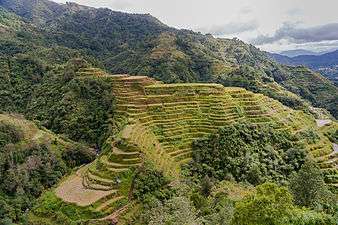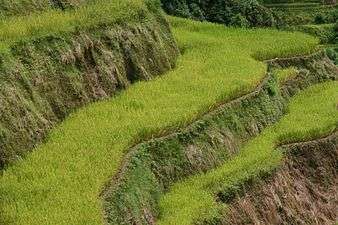Banaue Rice Terraces
| Banaue Rice Terraces | |
|---|---|
|
The Banaue Rice Terraces of Ifugao, Philippines | |
.svg.png) | |
| Location | Ifugao, Philippines |
| Coordinates | 16°54′38″N 121°3′15″E / 16.91056°N 121.05417°ECoordinates: 16°54′38″N 121°3′15″E / 16.91056°N 121.05417°E |
The Banaue Rice Terraces (Filipino: Hagdan-hagdang Palayan ng Banawe) are 2,000-year-old terraces that were carved into the mountains of Ifugao in the Philippines by ancestors of the indigenous people. The Rice Terraces are commonly referred to as the "Eighth Wonder of the World".[1][2][3] It is commonly thought that the terraces were built with minimal equipment, largely by hand. The terraces are located approximately 1500 metres (5000 ft) above sea level. They are fed by an ancient irrigation system from the rainforests above the terraces. It is said that if the steps were put end to end, it would encircle half the globe.[4]
Locals to this day still plant rice and vegetables on the terraces, although more and more younger Ifugaos do not find farming appealing, often opting for the more lucrative hospitality industry generated by the terraces. The result is the gradual erosion of the characteristic "steps", which need constant reconstruction and care. In 2010, a further problem was drought, with the terraces drying up completely in March of that year.[5]
Ifugao rice culture

The terraces are found in the province of Ifugao and the Ifugao people have been its caretakers. Ifugao culture revolves[6] around rice and the culture displays an elaborate array of celebrations linked with agricultural rites from rice cultivation to rice consumption. The harvest season generally calls for thanksgiving feasts, while the concluding harvest rites called tango or tungul (a day of rest) entails a strict taboo on any agricultural work. Partaking of the bayah (rice beer), rice cakes, and betel nut constitutes an indelible practise during the festivities.
The Ifugao people practise traditional farming spending most of their labour at their terraces and forest lands while occasionally tending to root crop cultivation. The Ifugaos have also been known to culture edible shells, fruit trees, and other vegetables which have been exhibited among Ifugaos for generations. The building of the rice terraces consists of blanketing walls with stones and earth which are designed to draw water from a main irrigation canal above the terrace clusters. Indigenous rice terracing technologies have been identified with the Ifugao’s rice terraces such as their knowledge of water irrigation, stonework, earthwork and terrace maintenance. As their source of life and art, the rice terraces have sustained and shaped the lives of the community members. Ifugao previously belong to the Mountain Province as a municipality but on June 18, 1966 in effect of Republic Act No. 4695, Ifugao became an independent province.
Organic farming
In March 2009 the Ifugao rice terraces were declared[7] free from genetically modified organisms (GMO). An event was organised in Dianara Viewpoint for this announcement where it was graced by Gov. Teodoro Baguilat, Mayor Lino Madchiw, Greenpeace campaigner for Southeast Asia Daniel Ocampo, and Cathy Untalan who was executive director of the Miss Earth Foundation. Before the announcement ceremonies, three mumbaki (traditional priests) performed an Alim, a ritual to ask for blessings where an animal is offered to the gods.
Tourism

Another thriving economy in the Banaue Rice Terraces is tourism.[8] The Tourism industry has developed a number of activities for visitors which may include the traditional sight seeing of the terraces and visits to the tribes at the foot of the terraces. A Mumbaki[9] (traditional Ifugao witch doctor) is also recommended[10] to visitors, these doctors can perform spiritual healing rituals. Domestic tourism however has gone down[11] over the past few years. A contributing factor to this is the treatment of domestic tourists by the local guides in the area where it has been reported that local guides are more willing to entertain foreign visitors. The Batad Environmental Tour Guides Association (BETGA) in association with the Batad Baranguay authorities are currently laying a concrete track down from the Batad Saddle to the village proper.
The park is featured on the reverse side of the 1985 series of the Philippine one thousand peso bill as well as the reverse side of the 2010 series of the Philippine twenty peso bill.
As a National Cultural Treasure
The Banaue Rice Terraces refer to the cluster close to the Banaue poblacion as seen from the viewpoint. Contrary to popular belief perpetrated by its inclusion on the twenty peso banknote, the Banaue Rice Terraces are not a UNESCO World Heritage Site. They were not included in the UNESCO inscription Rice Terraces of the Philippine Cordilleras due to the presence of numerous modern structures, making it score low in the integrity criterion of UNESCO.[12]
The five clusters inscribed as part of the Rice Terraces of the Philippine Cordilleras are Batad, Bangaan, Hungduan, Mayoyao Central and Nagacadan.[13] Batad and Bangaan are under the jurisdiction of the Municipality of Banaue but are not referred to as the Banaue Rice Terraces.
The Banaue Rice Terraces are however declared by the Philippine government as a National Cultural Treasure under Ifugao Rice Terraces by virtue of Presidential Decree No. 260 in 1973.[14]
Other notable rice terraces in Ifugao
Aside from the Banaue Rice terraces there are 4 other similar terraces,[15][16] Soil type here in this mountainous province are that ones like what they used to fabricate clay pot or a clay jar, (also used in the construction by burning or cooking the clay), the Batad Rice Terraces, Mayoyao Rice Terraces in Mayoyao, Hapao Rice Terraces and Kiangan Rice Terraces. The Batad Rice Terraces are located in Barangay Batad in Banaue, these terraces shaped resembles an amphitheatre. The Mayoyao Rice Terraces are for a rice variety called "tinawon",[17] a rare type of organic rice which are grown in red and white variety in these terraces. The Hapao Rice Terraces are located in Hungduan, these terraces are stone-walled from Sagada rock formation and date back to 650 AD.[18] The Kiangan Rice Terraces is similarly located in Banaue, here they grow the rice varieties of nagacadan and julungan.
Gallery
-

Banaue Rice Terraces (2008)
-

View of the town of Banaue from the rice terraces
-
Closer view of the The Banaue Rice Terraces (1)
-

Closer view of the The Banaue Rice Terraces (2)
See also
References
- ↑ Filipinasoul.com.‘The Best’ of the Philippines - its natural wonders
- ↑ National Statistical Coordinating Body of the Philippines. FACTS & FIGURES:Ifugao province
- ↑ About Banaue > Tourist Attractions
- ↑ Department of Tourism: Ifugao Province. Accessed September 04, 2008.
- ↑ Agence France-Presse Drought ravages famed Banaue rice terraces. 9 March 2010.
- ↑ World Heritage Sites and Schlessinger Media and ISBN 9781417103423
- ↑ "Ifugao rice terraces are GMO-free--officials". Philippine Daily Inquirer. Retrieved 2009-07-17.
- ↑ "Eighth Wonder of the World". Visit Banaue. Archived from the original on 2 June 2009. Retrieved 2009-07-17.
- ↑ "The Mumbaki". Philippine Daily Inquirer. Retrieved 2009-07-17.
- ↑ "Tribal rituals cleanse, unite towns". Philippine Daily Inquirer. Retrieved 2009-07-17.
- ↑ "Down on Domestic Tourism". Philippine Daily Inquirer. Retrieved 2009-07-17.
- ↑ "Banaue Rice Terrace". Retrieved September 4, 2014.
- ↑ "UNESCO World Heritage Centre". UNESCO. Retrieved 2011-01-01.
- ↑ "Presidential Decree No. 260 August 1, 1973". The Lawphil Project - Arellano Law Foundation. Retrieved September 5, 2014.
- ↑ "Banaue Rice Terraces". PhilSite. Retrieved 2009-07-17.
- ↑ "Ifugao Is Famous For...". Wow Philippines. Retrieved 2009-07-17.
- ↑ "Ifugao exports 2.5 tons of 'Tinawon' rice". PIA.gov. Retrieved 2009-07-17.
- ↑ "Rice Terraces-Banaue". Luz Palma. Retrieved 2009-07-17.
External links
| Wikimedia Commons has media related to Banaue Rice Terraces. |
- Preserving the vanishing culture of the Ifugao on YouTube
- Banaue Rice Terraces information
- The seed keepers' treasure (Rice Today, International Rice Research Institute)
- Bird's Eye View of an Enduring Rice Culture
.jpg)